Welcome to ADDOMEx!
 ADDOMEx is a group of researchers that is funded by the Gulf of Mexico Research Initiative to investigate the impacts of spilled oil and dispersants on the formation of an extracellular matrix called EPS (exopolymeric substances) formed by marine microbes that is thought to be instrumental in determining the fate of oil. EPS formed by marine microbes can aid in the formation of marine snow that is important in the self-cleansing capacity of natural waters. It does this by binding to and aggregating particulates, oil, and debris in the water, thus causing them to sink to the seafloor.
ADDOMEx is a group of researchers that is funded by the Gulf of Mexico Research Initiative to investigate the impacts of spilled oil and dispersants on the formation of an extracellular matrix called EPS (exopolymeric substances) formed by marine microbes that is thought to be instrumental in determining the fate of oil. EPS formed by marine microbes can aid in the formation of marine snow that is important in the self-cleansing capacity of natural waters. It does this by binding to and aggregating particulates, oil, and debris in the water, thus causing them to sink to the seafloor.
Marine snow has been found to aid both in the dispersal and in the sinking of oil droplets from oil spills; marine microbes and phytoplankton can even use the hydrocarbons found in the oil as a source of food! However, it is hypothesized that the addition of dispersants (used to literally disperse the oil into the water column, much like dish soap in a greasy pan) can impede the formation of marine snow. Our consortium aims to investigate these interactions to better understand how the presence of oil can trigger the formation of EPS and subsequently aid in its degradation.
ADDOMEx Team
2015
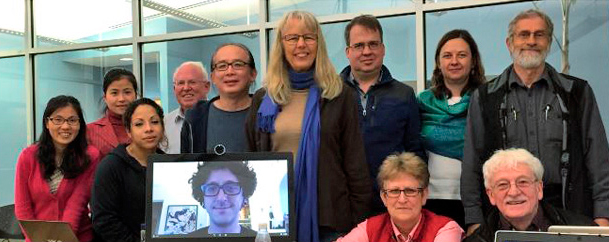
ADDOMEx team at initial hands on meeting in January 2015. Team members (left-to-right): Saijin Zhang, Chen Xu, Marcella Nunez, Patrick Hatcher, Wei-Chun Chin, Jason Sylvan (on screen), Uta Passow, Andrew Irwin, Kathy Schwehr, Antonietta Quigg (lead), Peter Santschi, Terry Wade and Zoe Finkel (photographer).
2016
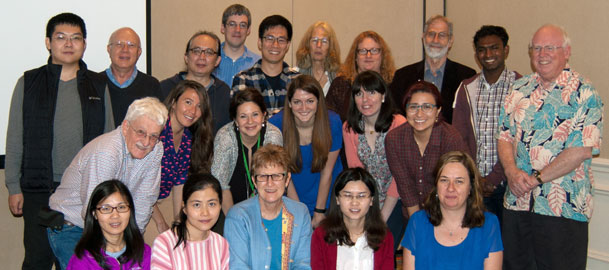
Team members (left to right, back row) David Shi, Gerardo Gold, Wei-Chun Chin, Shawn Doyle, James Chiu, Uta Passow, Zoe Finkel, Peter Santschi, Manoj Kamalanathan, Pat Hatcher, (middle row) Terry Wade, Maya Morales-McDevitt, Kendra Kopp, Jennifer Genzer, Laura Bretherton, Noemi Gold, (front row) Saijin Zhang, Chen Xu, Kathy Schwehr, Luni Sun, Antonietta Quigg (lead). Not pictured: Tony Knap, Jason Sylvan, Wassim Obeid, Josh Gunn, Chris Brown, Andrew Irwin, Steve Sweet, Julia Sweet,and Emily Whitaker.
New and Noteworthy
ADDOMEx Consortia's Graduate Student Has His Work Spotlighted by GOMRI This Month
November 9, 2017

Dawei Shi is a Ph. D student at Texas A&M University. He uses Chemical Fingerprinting to investigate oil in the water column. Follow this link to learn more about Dawei's exciting work! http://gulfresearchinitiative.org/grad-student-shi-uses-chemical-fingerprinting-investigate-oil-water-column/
Texas A&M Galveston Awarded $2.54 Million to Continue Researching Deepwater Horizon Spill
September 22, 2017
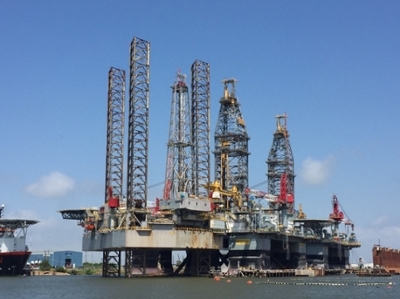
A research consortium led by Dr. Antonietta Quigg, professor of Marine Biology and associate vice president for Research and Graduate Studies at Texas A&M’s Galveston campus, was awarded $2.54 million by the Gulf of Mexico Research Initiative (GoMRI) to conduct scientific studies of the impacts of oil on the Gulf of Mexico ecosystem and public health. GoMRI is producing a rich legacy of research and technical innovation, with more than 915 peer-reviewed scientific articles and 3,600 scientific conference presentations to date. The proposals funded under RFP VI will contribute further to this growing knowledge base. Dr. Quigg’s project entitled “Aggregation and degradation of dispersants and oil by microbial exopolymers - ADDOMEx2” focuses on developing a better understanding of the molecular-level chemistry of sparingly-soluble substances in complex systems and the associated microbial communities. This research will continue the study the effects of the April 2010 Macondo well blowout, also known as the Deepwater Horizon oil spill, and will focus on improving our fundamental understanding of the implications of such events and on developing improved spill mitigation, oil and gas detection, characterization and remediation technologies. It is part of a grant funded by British Petroleum to 8 research consortia supporting research to be carried out from 2018 through 2019. Click here to read more about GoMRI research awardees.
Congratulations To Our GoMRI Scholars
July 25, 2017
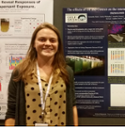

Dawei Shi and Samantha Setta, two Graduate Students on the ADDOMEx project, were recently named GoMRI scholars. The GoMRI Scholars Program recognizes outstanding graduate students and the vital research they contribute to improve understanding about the damage, response, and recovery following the Deepwater Horizon oil spill. The Scholars Program honors and builds community for these next generation of ocean science professionals. Congratulations Sam and David!
Math and computer science student collaborates on oil spill research project
July 14, 2017
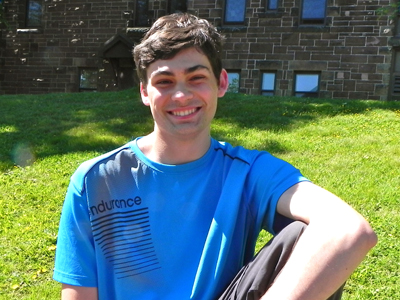 Mathematics and computer science student Michael Bradet-Legris is working this summer in the Marine Macroecology and Biogeochemistry Lab (MMAB) at Mount Allison. He is analyzing data from experiments conducted at Texas A&M University in Galveston. This is part of a project that is sponsored by GoMRI, the Gulf of Mexico Research Initiative, which is examining the effect of oil spills on the environment and public health and was motivated by the oil spill in the Gulf of Mexico. Environmental science professor and MMAB Lab member Dr. Zoe Finkel is collaborating with researchers in a multi-university consortium that received $7.25 million from GOMRI to study the impact of the oil spill. “To clean up the oil spill, dispersants were added without really knowing what would happen. We are looking at how marine life is affected when dispersant is mixed with oil in water, particularly the little guys, phytoplankton and bacteria,” says Bradet-Legris. Mathematics and computer science professor and MMAB Lab member Dr. Andrew Irwin is Bradet-Legris’s supervisor on the project. “It has been great to have Michael working with us this summer. He demonstrates what you can do in an interdisciplinary lab. He comes with lots of great math and computer skills and he is working in a lab with people who do all types of biology research, so he had to learn that material as well. He has done many, many calculations for us.” Bradet-Legris is glad for the experience applying the tools he knew already and learning new ones. “Many math and computer science people dabble in numerous different fields because you can apply math and computer science to lots of different areas, as many people need statistics or programming skills for their projects,” he says. The experiment running in Texas has large tanks where different scenarios are tested, including the effects of dispersant and oil on specific species. Bradet-Legris is working with huge quantities of data from these experiments in the form of RNA from the phytoplankton. “My job is basically looking at all this data and figuring out what species were in the tanks. Essentially we look at the ribosomal RNA to see which communities are growing and which are declining because of the environmental conditions. Then we look at the messenger RNA to see how they are adapting. We then compare the results and hopefully will be able to make conclusions,” says Bradet-Legris.
Mathematics and computer science student Michael Bradet-Legris is working this summer in the Marine Macroecology and Biogeochemistry Lab (MMAB) at Mount Allison. He is analyzing data from experiments conducted at Texas A&M University in Galveston. This is part of a project that is sponsored by GoMRI, the Gulf of Mexico Research Initiative, which is examining the effect of oil spills on the environment and public health and was motivated by the oil spill in the Gulf of Mexico. Environmental science professor and MMAB Lab member Dr. Zoe Finkel is collaborating with researchers in a multi-university consortium that received $7.25 million from GOMRI to study the impact of the oil spill. “To clean up the oil spill, dispersants were added without really knowing what would happen. We are looking at how marine life is affected when dispersant is mixed with oil in water, particularly the little guys, phytoplankton and bacteria,” says Bradet-Legris. Mathematics and computer science professor and MMAB Lab member Dr. Andrew Irwin is Bradet-Legris’s supervisor on the project. “It has been great to have Michael working with us this summer. He demonstrates what you can do in an interdisciplinary lab. He comes with lots of great math and computer skills and he is working in a lab with people who do all types of biology research, so he had to learn that material as well. He has done many, many calculations for us.” Bradet-Legris is glad for the experience applying the tools he knew already and learning new ones. “Many math and computer science people dabble in numerous different fields because you can apply math and computer science to lots of different areas, as many people need statistics or programming skills for their projects,” he says. The experiment running in Texas has large tanks where different scenarios are tested, including the effects of dispersant and oil on specific species. Bradet-Legris is working with huge quantities of data from these experiments in the form of RNA from the phytoplankton. “My job is basically looking at all this data and figuring out what species were in the tanks. Essentially we look at the ribosomal RNA to see which communities are growing and which are declining because of the environmental conditions. Then we look at the messenger RNA to see how they are adapting. We then compare the results and hopefully will be able to make conclusions,” says Bradet-Legris.
Bioinformatics Bootcamp with at Auburn University Auburn, AL
June 27, 2017
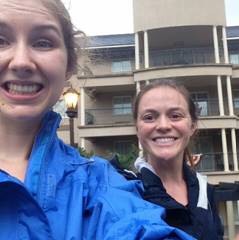 Catherine Fiset and I attended the Auburn Bioinformatics Bootcamp in Auburn, Alabama for five days in June. Catherine and I both a had only a fair amount of experience with computing heading into the boot camp, so we were a little nervous about the pace of the class. Upon arriving in Auburn it started raining on us (see picture), and the rainfall continued for the next few days. On the first day we arrived we met our instructors Dr. Scott Santos, Dr. Les Goertzen, Dr. Laurie Stevison, Dr. Rita Graze, and Dr. Jamie Oaks. We also met the three assistant PhD students who would help us through each exercise, Nicole Garrison, Nathan Hall, and Mike Tassia. Each of the instructors and assistants covered their area of expertise and a wide range of bioinformatics topics. Some of these topics included genome and transcriptome annotation and assembly, good habits for data storage, and the plethora of databases available for bioinformatics. On the third day, we met our final instructor Ken Halanych who was generous enough to give us a tour of all of the equipment and collections in the Halanych lab at Auburn. On the second to last day we also had a guest lecturer, Dr. Nirav Merchant and attended his talk on ‘Unleashing Your Inner Data Scientist’ to Auburn University Faculty and students. Altogether, Catherine and I were very happy with the amount of material covered and the attention we got from both instructors and assistants on topics in which we were novices. Catherine Fiset will be working on projects with Zoe Finkel and Andrew Irwin that are applications of these topics and revolve around bioinformatics analysis. The lectures and exercises we took part in directly apply to my Master’s Thesis in the Quigg Lab and I was happy to get a solid bioinformatics foundation to build my analysis. Both Catherine and I were thrilled to travel to Auburn as part of the ADDOMEx team, meet people in the bioinformatics field, and learn new techniques that will be invaluable during data analysis.
Catherine Fiset and I attended the Auburn Bioinformatics Bootcamp in Auburn, Alabama for five days in June. Catherine and I both a had only a fair amount of experience with computing heading into the boot camp, so we were a little nervous about the pace of the class. Upon arriving in Auburn it started raining on us (see picture), and the rainfall continued for the next few days. On the first day we arrived we met our instructors Dr. Scott Santos, Dr. Les Goertzen, Dr. Laurie Stevison, Dr. Rita Graze, and Dr. Jamie Oaks. We also met the three assistant PhD students who would help us through each exercise, Nicole Garrison, Nathan Hall, and Mike Tassia. Each of the instructors and assistants covered their area of expertise and a wide range of bioinformatics topics. Some of these topics included genome and transcriptome annotation and assembly, good habits for data storage, and the plethora of databases available for bioinformatics. On the third day, we met our final instructor Ken Halanych who was generous enough to give us a tour of all of the equipment and collections in the Halanych lab at Auburn. On the second to last day we also had a guest lecturer, Dr. Nirav Merchant and attended his talk on ‘Unleashing Your Inner Data Scientist’ to Auburn University Faculty and students. Altogether, Catherine and I were very happy with the amount of material covered and the attention we got from both instructors and assistants on topics in which we were novices. Catherine Fiset will be working on projects with Zoe Finkel and Andrew Irwin that are applications of these topics and revolve around bioinformatics analysis. The lectures and exercises we took part in directly apply to my Master’s Thesis in the Quigg Lab and I was happy to get a solid bioinformatics foundation to build my analysis. Both Catherine and I were thrilled to travel to Auburn as part of the ADDOMEx team, meet people in the bioinformatics field, and learn new techniques that will be invaluable during data analysis.
Grad Student Morales-McDevitt Explores How Nutrients Influence Marine Snow Formation
June 16, 2017
 Marine oil snow is the largest commuter of carbon to the seafloor and occurs when oil and marine particles aggregate and sink through the water column. Previous studies show that oil and dispersant significantly increased marine microorganisms’ production of exopolymeric substances (EPS), an extremely sticky goo that holds marine snow together. Maya Morales-McDevitt conducts mesocosm experiments investigating how certain naturally occurring nutrients influence EPS production and oil degradation.
Marine oil snow is the largest commuter of carbon to the seafloor and occurs when oil and marine particles aggregate and sink through the water column. Previous studies show that oil and dispersant significantly increased marine microorganisms’ production of exopolymeric substances (EPS), an extremely sticky goo that holds marine snow together. Maya Morales-McDevitt conducts mesocosm experiments investigating how certain naturally occurring nutrients influence EPS production and oil degradation.
Maya is a chemical oceanography student at Texas A&M University and a GoMRI Scholar with Aggregation and Degradation of Dispersants and Oil by Microbial Exopolymers (ADDOMEx).
Her Path
Maya discovered her love for the marine environment while attending a science-based high school in Mexico City, Mexico. Watching trash and oil pollutants negatively affect Mexico’s marine ecosystems broke her heart and inspired her to pursue research that demonstrates the importance of regulating oil pollution. “Oil pollution regulations aren’t very clear in Mexico,” she explained. “I wanted to contribute something that would keep the environment clean and reduce our footprint in the ocean.”
Maya’s undergraduate biology thesis at the Universidad Autónoma Metropolitana (UAM) México investigated how oil activity influences mussels. There were no active projects at the time, so she used the resources around her to conduct her own project. She asked her scuba instructor to take her on mussel-collecting excursions and washed dishes in various UAM and UNAM (Universidad Nacional Autónoma de México) laboratories in exchange for running analyses using their equipment. She presented her research at several international ecology conferences in Mexico. “When the person I was working with in Mexico put me in touch with Dr. Tony Knap, he told me to come [work in his lab], so I came,” she recalled. “Five or six months later, the ADDOMEx project started.”
Her Work
Maya used a 120 L tank to simulate the natural marine environment and created various mixtures of seawater, oil, dispersant. She examined each mixture once using the collected seawater’s indigenous nutrients (non-fertilized treatments) and again with added concentrations of nitrogen and phosphorus (fertilized treatments). She collected samples from each treatment and compared the differences in oil degradation, marine snow generation, and chlorophyll concentrations.
Maya observed that nitrogen and phosphorus were biodegraded at similar rates, indicating that both are important to oil degradation processes. While nutrient degradation was high across all treatments including controls, nutrient enhanced treatments exhibited greater oil biodegradation than non-fertilized treatments. She found the strongest evidence of biodegradation in the diluted and concentrated oil plus dispersant treatments from the coastal water experiments. Oil plus dispersant treatments also experienced sharp reductions in chlorophyll and exhibited the greatest amounts of marine snow.
Maya’s research suggests that adding nutrients could enhance oil’s natural removal from the water column alongside weathering processes such as marine snow sedimentation and biodegradation. Her work also supports the hypothesis that dispersant enhanced EPS production and, thus, increased marine snow. Her findings will help inform decision makers about ways to lessen oil spills’ environmental impacts. “The initial interest in marine snow and EPS was the possibility that they aided oil removal, but the new train of thought is that the excessive marine snow related to Deepwater Horizon caused more hostile effects than good ones,” she said. “In order to prevent [these hostile effects], we need to understand how it works.”
Her Learning
Maya’s research showed her that scientists must consider the chemistry, physics, and biology of an ecosystem to understand it. Once their knowledge about these factors is improved, they are better equipped to find answers to their research questions. She remarked that one of the best ways to do this is to collaborate with other scientists. “We have physicists and chemists and biologists at our ADDOMEx All-Hands meetings who are all trying to solve problems. I think that has been one of my greatest experiences and the biggest lessons that I’ve learned in my master’s program,” she said.
Maya is particularly thankful for the support that she and other students received from the ADDOMEx team. She is most proud of how she and her team designed and built a baffled recirculation tank from scratch for their experiment. “It was very moving the way the PIs were always supporting us, pushing us to do more and do better and giving us all the advice that they could,” she said. One of her favorite memories is the struggle to fit fifteen researchers into the small, dark workspace surrounding the tanks. “I needed to be close to the tanks under very low light to take my samples. I ended up working in the men’s bathroom next to the dark room in order to take them! I will never forget my ‘laboratory’ in the men’s facilities,” she laughed.
Her Future
Shortly after graduating, Maya began a laboratory technician position with Texas A&M University’s Geochemical and Environmental Research Group (GERG) and hopes to begin a Ph.D. program in 2018. She says that persistence is the key to her success and advises students pursuing science to focus on their goals, even when the road is difficult. “You don’t need to be a genius or the most-outstanding student in your class, you just need to be determined,” she said. “If you fight enough, read enough, and do enough research and lab work, you will get wherever it is you want to go.”
Praise for Maya
Dr. Knap reflected that Maya’s work building mesocosms and running experiments often involved late nights and long days. While working in his lab, Maya learned to operate various instruments including fluorometers, gas chromatographs, and auto-analyzers, which he said could often be a highly involved process. “Maya is a hard-worker and very cheerful individual,” he said. “She is a great team player, and it was a pleasure to have her involved with our programs at GERG.”
The GoMRI community embraces bright and dedicated students like Maya Morales-McDevitt and their important contributions. The GoMRI Scholars Program recognizes graduate students whose work focuses on GoMRI-funded projects and builds community for the next generation of ocean science professionals. Visit the ADDOMEx website to learn more about their work.
On July 8th, thirty scientists from ADDOMEx descended upon Texas A&M University at Galveston to perform an experiment which would examine the effects of oil and dispersants on the microbial communities in the Gulf of Mexico. Faculty, staff and students - undergraduates, graduates, high schoolers and NSF REU (Research Experiences for Undergrads) from across the country (UC Santa Barbara, Old Dominion University, Mount Allison University and UC Merced) and Canada teamed up to look at the differences between processes occurring in the open ocean and those in coastal zones.
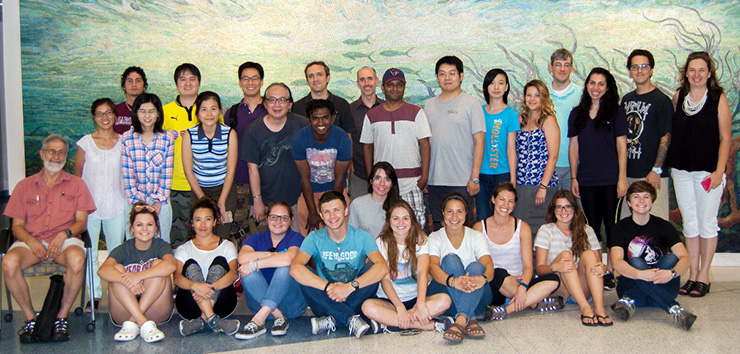
ADDOMEx researchers and students who participated in these experiments.
Aboard the RV Trident they collected water from the Flower Garden Banks, roughly 120 miles off the Texas coast, and from Tabs Buoy R, miles off Sabine Lake in west Louisiana. The researchers observed that the bacterial community dominated the response of samples from the open ocean while phytoplankton were more important in coastal waters. In the coming months, they will process 1000’s of samples collected, with anticipation of presenting their findings at the next Gulf of Mexico Oil Spill and Ecosystem Science conference schedule to be held in New Orleans (February 2017).
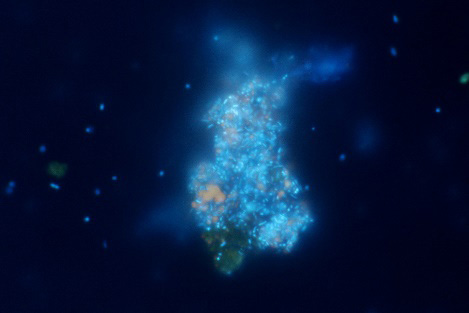
The bacterial community.
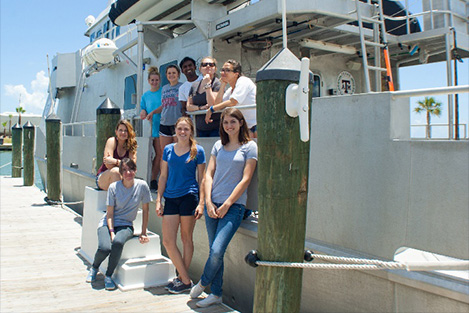
The scientific crew who collected samples on the first Trident cruise.
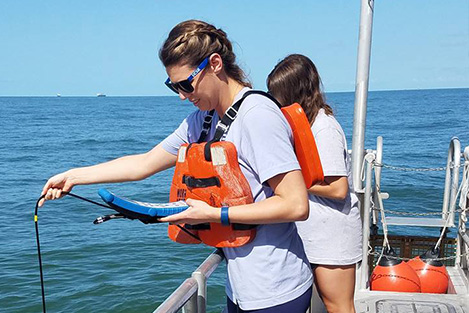
Julia Sweet uses a Hydrolab to measure various water parameters during the second cruise.
ADDOMEx Team Members Host a Lab Exchange
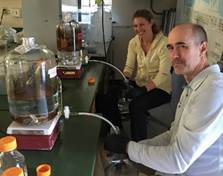 Just before Christmas, ADDOMEx members from Texas A&M University at Galveston (TAMUG), as well as Mount Allison University in Canada travelled to Santa Barbara, CA to participate in a lab exchange. Dr. Uta Passow and her lab manager Julia Sweet from the University of California Santa Barbara (UCSB) hosted this exchange in an effort to streamline the protocols that are used by the consortium when forming aggregates in roller tables.
Just before Christmas, ADDOMEx members from Texas A&M University at Galveston (TAMUG), as well as Mount Allison University in Canada travelled to Santa Barbara, CA to participate in a lab exchange. Dr. Uta Passow and her lab manager Julia Sweet from the University of California Santa Barbara (UCSB) hosted this exchange in an effort to streamline the protocols that are used by the consortium when forming aggregates in roller tables.
Roller tables have been used for some time by Dr. Passow to form and study aggregates. These tables function by slowly spinning circular tanks that have been completely filled with water. The speed of the rolling tank (and the lack of air bubbles inside) is such that solid body rotation is established and the aggregates in the tank are moved up with the body of water while they sink, effectively keeping them from falling out of suspension.
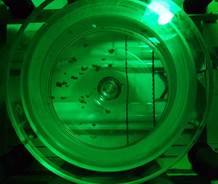 “I was fascinated by both the approach and the way the experiment unfolded.” Says Chris Brown, a participating researcher from Mt. Allison, “The roller tank design allows aggregates to continually sink, grow and change, simulating an extended sinking event from the upper ocean to the depths.”
“I was fascinated by both the approach and the way the experiment unfolded.” Says Chris Brown, a participating researcher from Mt. Allison, “The roller tank design allows aggregates to continually sink, grow and change, simulating an extended sinking event from the upper ocean to the depths.”
Sinking aggregates (such as those pictured at right) are important for bringing nutrients from the surface of the ocean to its depths; they can also collect oil droplets from a spill as they sink, potentially exposing the droplets to oil degrading micro-organisms.
“This experiment broadened my exposure to diatom ecology research.” He says, “I look forward to seeing the molecular level data on the algal gene expression as well as the response of the bacterial community.”
Another benefit of the lab-exchange was that it allowed the researchers to discuss differences in the functionality of the roller tables that are used at different research institutions. This was particularly helpful for Cameron Jackson, an undergrad from TAMUG who accompanied the group. Cameron has been primarily responsible for the design and construction of the roller tables at the A&M campus.
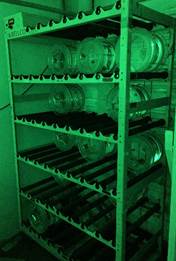 “For example, at UCSB the roller table is designed like a bookcase with multiple shelves at varying heights, while at TAMUG the roller tables have been designed to be a single long continuous shelf,” says Alicia Williams from TAMUG.
“For example, at UCSB the roller table is designed like a bookcase with multiple shelves at varying heights, while at TAMUG the roller tables have been designed to be a single long continuous shelf,” says Alicia Williams from TAMUG.
“Because the tanks can “walk” or move along the rolling components if not properly balanced or limited in some way, discussing potential options to
prevent this problem given our different set-ups was invaluable.”
Additionally, the lab exchange fostered better communication and collaboration within the ADDOMEx teams. “The exchange of information was by no means one-sided,” Alicia continues, “I was involved in the measurement of fluorescence associated with the water accommodated fraction of oil during the experiment, which I have done extensively at TAMUG. By actively doing this with host lab team members, we were able to discuss problems and solutions we had both encountered, ultimately coming up with standard practices to be applied together in the future.”
Julia Sweet was particularly happy with the results, “The Passow Lab benefited immensely from the manpower and expertise of our visitors. Having a visiting team of energetic and competent scientists allowed us to complete an experiment which would have been impossible to attempt without assistance.”
Following such a successful week of experimentation, ADDOMEx team members would definitely recommend a similar lab exchange to other research groups.
Jennifer Genzer, a research assistant from TAMUG states “I can’t imagine a better way of trading knowledge among a group of scientists. Exchanging protocols is one thing, but having the chance to discuss different methods and to appreciate how key the timing is of a roller tank experiment, is another. We gained invaluable tricks of the trade from visiting the wonderful Passow Lab that I don’t believe we could have learned any other way.”
Additionally, samples from this experiment were shipped to the other ADDOMEx teams across the United States for further analysis. Analyses of the aggregates included understanding the chemical and community composition, phytoplankton physiology, oil concentrations, etc., and findings were presented at the Gulf of Mexico Oil Spill Ecosystem Conference in Tampa, Florida.
High School Student Investigates the Degradation of Oil Spills
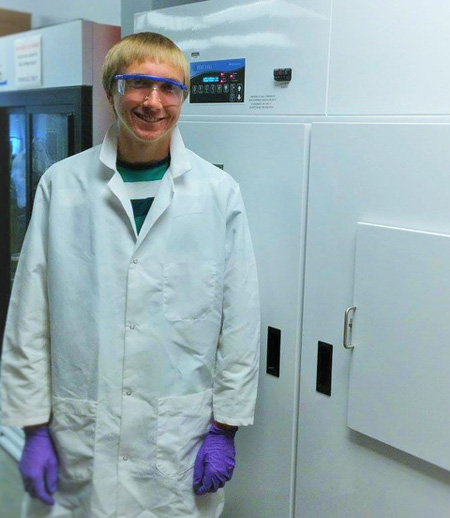
Thomas stands next to the diurnal chamber that is used to expose
samples to similar light as would be found in the marine environment.
“It all started with an email,” says Thomas Mathwig, a high school senior from Ocean Lakes Mathematics and Science Academy in Virginia.
Thomas’ interest in chemistry prompted his teachers to recommend that he contact Dr. Pat Hatcher at Old Dominion University about potential research opportunities on which he could base his senior project.
“Dr. Hatcher and I met up to talk about his research and it was during this meeting that I met Wassim.” Says Thomas.
Wassim Obeid is a post-doctoral scholar Dr. Hatcher; both researchers are members of the ADDOMEx team and are investigating the effects of weathering on oil that is released into the ocean as a result of oil spills. Thomas is helping Wassim analyze how light can contribute to these effects.
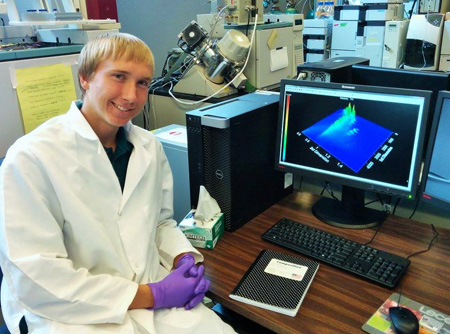
Thomas demonstrates a typical computer read out of 2D Gas Chromatography.
“The experiment is called The Effect of Photo-bleaching on Oils. So we’re studying the photodegradation of oils by exposing samples of Macondo oil to UV rays in a growth chamber to simulate what happened during the Deepwater Horizon oil spill. We want to know how different amounts of light will affect the chemistry of oil in an oil spill.”
“The most excited I've been was when we were talking about gas chromatography and I got to actually look at the results (called a chromatograph) of our experiment on screen.” Says Thomas.
Gas chromatography works by heating a sample until it turns into a gas. This gas is then passed through a long column that will separate the components of the sample based upon size and polarity.
“Gas chromatographs are really cool machines that I didn't even know existed. So being able to learn about and observe these machines has been the most interesting part of this research for me”.

A chromatogram of the results of a sample analysis.
The taller the peak, the greater the concentration of a particular compound in the sample.
Thomas has been responsible for helping Wassim integrate the area found under each of the peaks in the chromatogram results. This helps them calculate exactly how much of each compound are in the samples.
“I’ve gotten a look at how the professional world uses the scientific method and conducts science: in a controlled environment, with lots of precise instruments. I’ve had to create and run several experiments in school, and even though I try the best I can to perfect them, they’re still pretty flawed in comparison.”
“I’ve also learned how much time it takes to conduct research like this. It can be really time consuming to get the results that you need. High school experiments might take a while, but they just aren’t on the same caliber.”
Thomas will be writing a paper on his research during the academic year, complete with a literature review. He will also be presenting his work at the Tidewater Science Fair in March. After graduating high school, he plans on attending a university, although he’s not sure which one yet.
“Chemistry is definitely a major I would be interested in. But in the STEM field in general there is a lot of cool stuff. But chemistry is highest on my list right now.”
ADDOMEx Team Meeting
ADDOMExers recently gathered on the campus of Texas A&M Universities at Galveston.
The purpose of this meeting was to test drive the large tanks (mesocosms) that will be used to house microbial (bacterial and plankton) communities while studying how oil and dispersants affect their growth and the formation of aggregates. To do this, four mesocosms were filled with seawater and inoculated with plankton from the Gulf. Mesocosms were treated with oil and oil plus dispersant.

Over about a week, ADDOMEx team members followed changes in both the biology and chemistry.

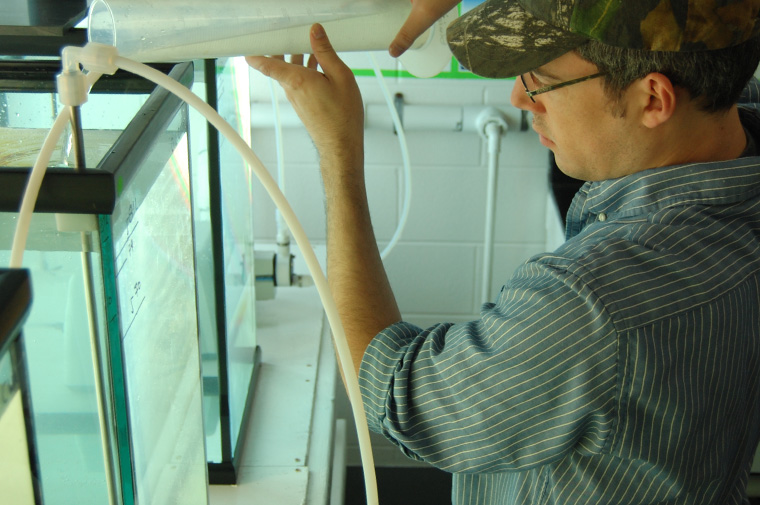
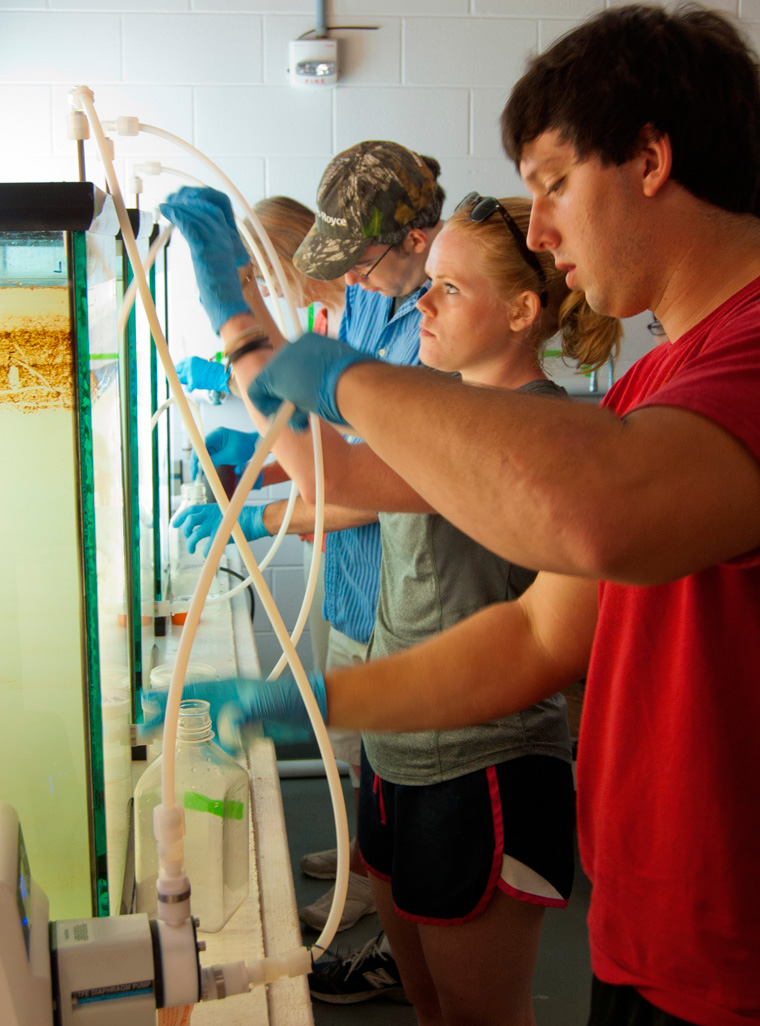
The inoculated microbial communities were allowed to grow and depending on conditions, form aggregates. Subsamples of the water and the aggregates were taken every 8 to 24 hours for several days. These subsamples are currently being analyzed by different members of the ADDOMEx team with hopes to present findings at the upcoming GOMRI meeting in Tampa Florida. The activity was amazingly informative. Not only will the results be instrumental in directing future experimentation but the samples collected during this meeting will be extremely helpful for fine tuning the various protocols that will be used presently and in the future. Dealing with “contamination” from the oil and dispersant has proved to be in some cases an unexpected additional challenge to what had previously been routine protocols.
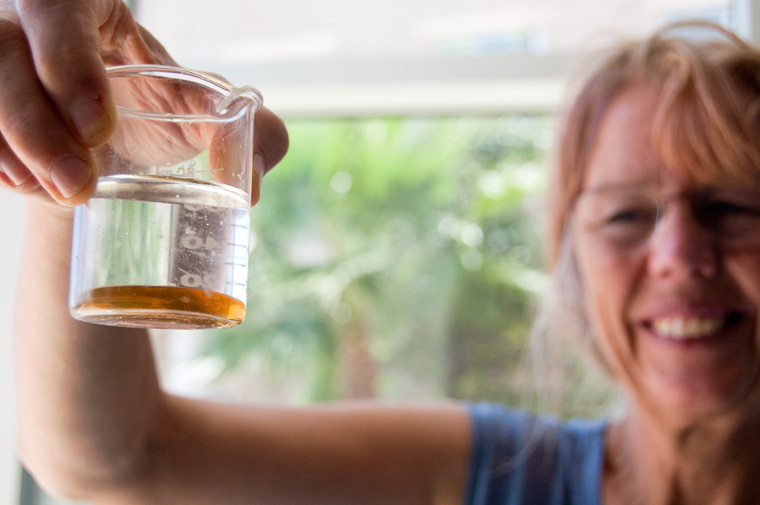
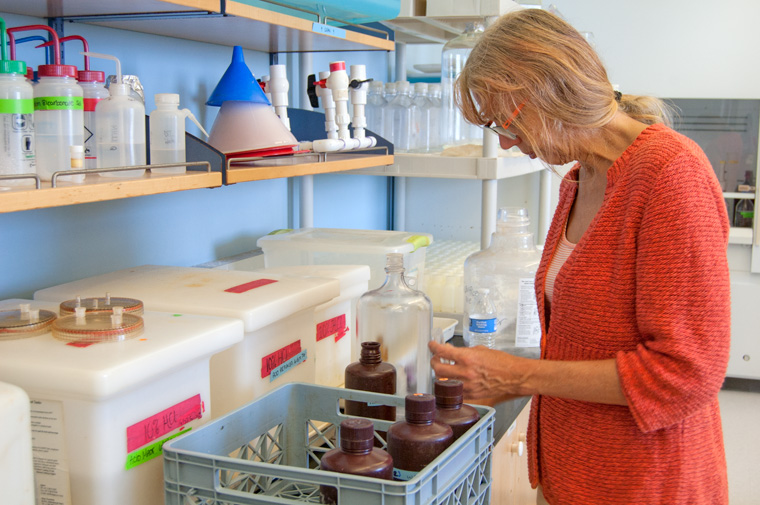
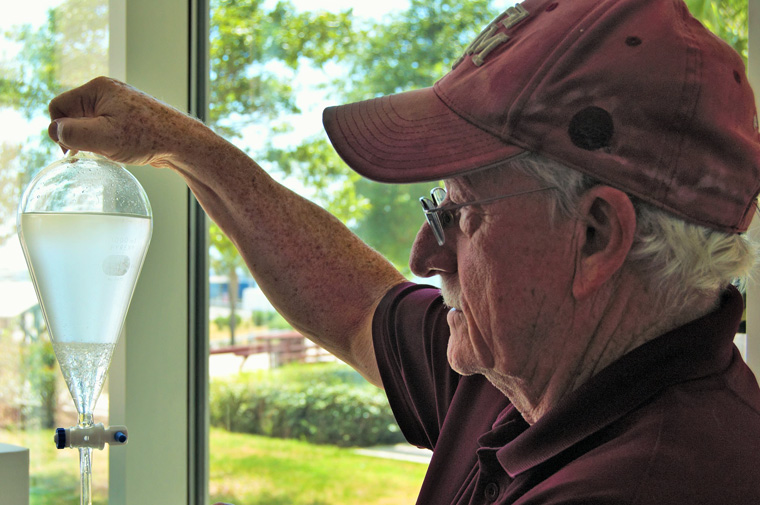
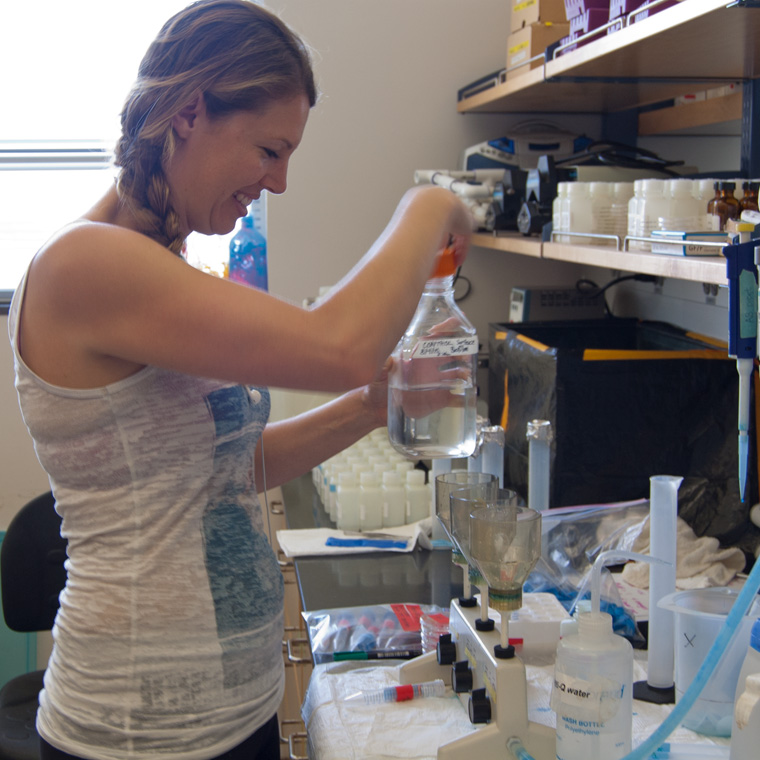
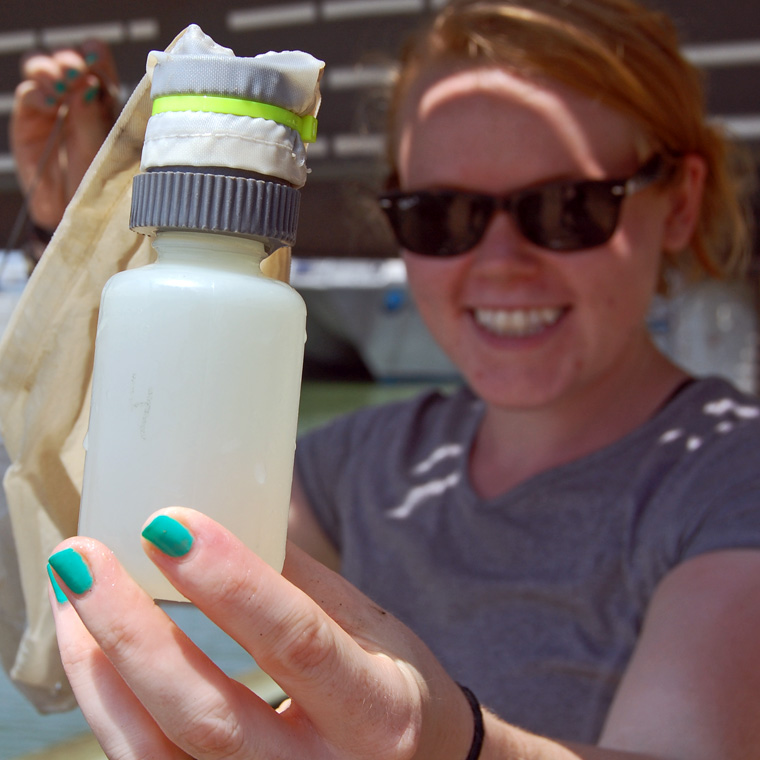
In addition to lots of experimentation, ADDOMEx teams collaborated to calibrate several fluorometers (Horiba, Perkin-Elmer, Shimadzu and Turner) that they will use to measure the concentration of oil in their samples. This will ensure consistency in measurements over the course of experimentation and importantly between team members spread across the country.
Along with the original team members, newly hired postdoc’s, grad students as well as high school students and summer interns joined the fun!
Meet Cameron and Oscar, two undergrads that have been working with the team at Texas A&M University at Galveston (TAMUG, www.tamug.edu).
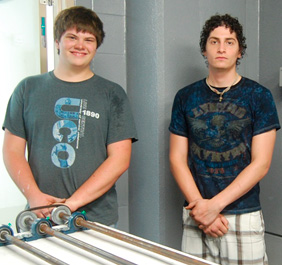
Cameron Jackson (left) and Oscar Agueda (right)
Cameron Jackson, a sophomore, is studying marine biology (TAMUG) and Oscar Agueda is a senior who will be getting his degree in marine science (TAMUG); both students are minoring in chemistry. When asked about career aspirations they stated that they hoped to go on to graduate school. “I want to do deep-sea research; bioluminescence in particular is something that really interests me” says Cameron. Oscar, on the other hand, is more interested in ocean and environmental sciences “So I’m right where I need to be”.
Both students approached Dr. Peter Santschi and Dr. Kathy Schwehr of LOER lab (Laboratory for Oceanographic and Environmental Research) in hopes of gaining valuable research experience. Drs. Santschi and Schwehr are principal investigators for ADDOMEx (Aggregation and Degradation of Dispersants and Oil by Microbial Exopolymers, https://www.tamug.edu/phytoplankton/projects/addomex/), one of several consortia that are funded by the Gulf of Mexico Research Initiative (GoMRI, www.gulfresearchinitiative.org) to research the impacts of oil spills on the marine environment.
The students have been working to build a roller table that will be used for a set of experiments conducted by ADDOMEx. Advice and specifications for the roller tables have been provided by Dr. Uta Passow, a fellow researcher from the University of California Santa Barbara.
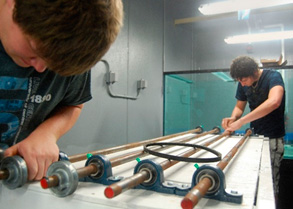
Fitting the rods that will hold the cylindrical
tanks to the table.
The roller table will be used keep samples of phytoplankton and microbes in constant motion to study the formation of marine snow with and without the addition of oil and Corexit (a common dispersant used to treat oil spills).
“It’s like a shaker table, but for a cylindrical tank”, says Oscar.
“I think my dad put it best,” Cameron explains which a chuckle, “in that the roller table is essentially a glorified hot dog cooker at a convenience store. And this is really the perfect way to think about it because it continually rolls the tanks in a horizontal manner.”
“The roller tables will be used to mimic the movement of water in the ocean” says Cameron. “Stagnant water really doesn’t exist in the ocean, and using standing water in our experiments would create conditions that don’t accurately reflect what is happening in the ocean.”
“It’s been a challenge to invent ways to overcome little problems like ensuring that the screws, bolts, and mounts were the proper size” he goes on. “For the first three or four days I didn’t have a drill, so I put the frame together using a screwdriver. I actually broke the screwdriver.”
When asked how this project has changed their perspectives on how research is done, Cameron stated that he “always imagined that you just buy any instruments you might need, so being told to actually design and build the roller tables was a bit of a surprise.”
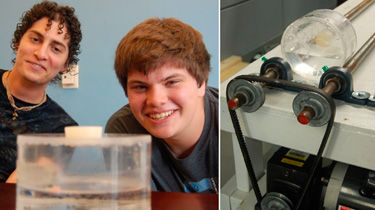
Oscar and Cameron in front of a cylindrical tank that will be used
to house samples on the roller table (left) and the positioning
of the tank on the table (right).
“I expected that we would be in the lab most of the time” said Oscar. “Instead we’ve been outside working on the table almost every day, but it’s been fun. I would definitely recommend working in a lab to other students, it looks great on your resume… just be prepared to get sweaty!”
According to Cameron you should “bring a pair of headphones”.
After finishing the roller tables, the students will be moving on to work that will include measuring the tensile strength and hydrophobicity/hydrophilicity of the exopolymeric substances that are produced by the study species of marine phytoplankton and microbes in upcoming experiments.
Follow us on Facebook (www.facebook.com/addomex/), Twitter www.twitter.com/addomex/, and Instagram www.instagram.com/addomex/.
